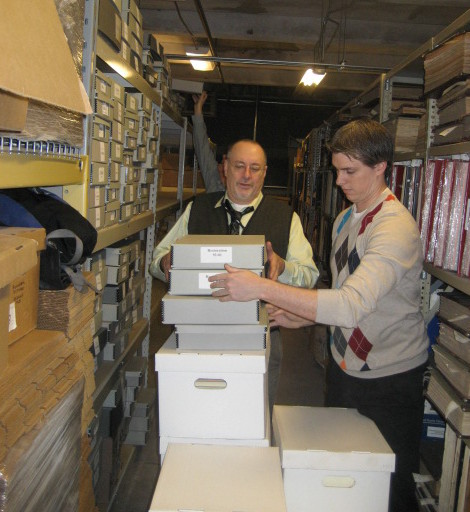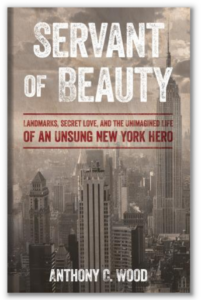How APT Saved its Archives: An Inspiring Model for Preservation Institutions
June 6, 2019 | Elizabeth Rohn Jeffe, Vice-Chair of the Archive Project
Despite the frequent tales of crushing losses or dramatic rescues often related to preservation archives, there are many success stories. One outstanding example of such a success is the preservation of the archival materials of the Association for Preservation Technology International (APT). Founded in Canada in 1968 and now headquartered in Springfield, Illinois, APT is a membership organization including a wide range of professionals in many fields related to preservation. APT seeks to promote the best technologies to care for, protect, and promote the longevity of the built environment and cultivate the exchange of related information to an international audience. In line with that mission, APT’s archives were saved and organized in the 1990s and have been housed at the Athenaeum of Philadelphia since 2009.
At the heart of the APT archives story is Lonnie Hovey, an architect whose specialty is historic preservation with an emphasis on adapting old buildings for new uses while retaining their historic character. At present, he is an Associate and Senior Preservation Architect at the firm of Whitman, Requardt & Associates in Philadelphia; his impressive resume includes architectural preservation projects involving the East and West Wings of the White House, Philadelphia City Hall, the Cleveland Museum of Art, and other, but still significant projects focused on smaller historic structures. An enthusiastic member of APT since 1988, Hovey became aware in 1999, while working as an architect in a previous firm, that old records of completed projects were about to be thrown in dumpsters as part of plans to “clean house.” It occurred to Hovey that clients might find these records of their own projects, with critical architectural histories and details about their buildings, highly valuable. As Hovey puts it, “these plans and materials showed the buildings at their most vulnerable,” and were therefore of enormous importance to anyone owning or residing in the structures should they need to renovate or make repairs in the future. Sure enough, over 50% of the clients he called requested their records, and the others agreed that the materials should be sent to a local repository.

Hovey next became directly involved with the idea of saving APT’s records. He had joined the Octagon Museum in Washington, D.C. in 1989, and APT had moved its headquarters from Quebec to Fredericksburg, Virginia, in 1988, so proximity helped. After APT’s Fredericksburg office closed in 1995, Hovey and a few other APT volunteers began in earnest to sort through the APT office papers, then housed in Maryland. Hovey observes that although he is not a professional archivist, he and his colleagues Tom Taylor, a former vice president of APT who would go on to serve as de facto archivist for 14 years, Tom Jester, and Bill Barlow had a “crash course” in this discipline by dint of hands-on experience. Culling out extraneous materials, the team saved what was pertinent to APT’s history and to its mission of publishing and sharing information on the technology of preservation. In 1996, the year in which the materials became a true archival collection, they were moved to a temperature-controlled warehouse space in Colonial Williamsburg.
At this juncture, the organization and protection of the materials reached a new level of sophistication under the stewardship of conservator Thomas H. Taylor, Jr., Chief Architectural Conservator with the Colonial Williamsburg Foundation’s Department of Architectural Research. Hovey describes Taylor as “the first real archivist of the APT collection.” Taylor employed interns from the College of William & Mary to help sort materials and place them in archival folders and boxes. When this phase of the project reached completion in 2008, Hovey began a search for a permanent home for the APT collection. After considering several repository options, APT selected the Athenaeum of Philadelphia, whose collections center on building technology, architecture, and interior design. It was a logical fit. When it came time to move the archives from Williamsburg to Philadelphia in 2009, Hovey and other APT members personally offloaded the boxes from a truck for delivery at the Athenaeum where Hovey is now the official APT liaison.
The collection, the largest at the Athenaeum, now stands at about 130 “bankers boxes” in size. It had been larger, but Hovey again engaged in culling and carefully weeded out duplicates of APT publications, keeping one copy of each, now available on JSTOR. He also continues to receive new materials on a regular basis. One of his initiatives is to request that APT members do some “spring cleaning” and send him any records, plans, documents, programs, minutes, lists of officers and committee members, and other APT items that they have. To keep APT members aware of the archive, Hovey contributes a regular feature in the APT publication, Communiqué, in which he highlights items from the archival collection. In order to create interesting articles for readers, he says that he will ask himself a question and see what the archives have to say on that subject. If the collection is silent, he reaches out to members to help fill in the story. A case in point is finding the histories of some of APT’s early officers, about whom there is little in the archives. Thus, Hovey’s research on these leaders helped to uncover new information about key figures in the early history of APT.
While the principal users of the APT collection are architectural historians and APT members (according to Hovey “there’s not a flood” of other users), this community of researchers is a significant one. As Hovey points out, many new members of APT do not really know its story, and the archives provide a rich source for them to learn more about the 51-year-old organization. There are also creative and “fun” uses of the materials: for APT’s Fiftieth Anniversary celebration in 2018, resources in the archives were used to create photographic centerpieces reflecting the various typefaces, graphics, and covers of APT’s publications over the years.

Hovey visits the collection in person several times a year, but interacts with it remotely on a weekly basis. As new things arrive at his office, he scans them to create an electronic archive. Ever the dedicated volunteer, Hovey also helped launch a new APT initiative, the Legacy Project, in 2012. (While Hovey is the Legacy Project’s chair, he is quick to point out that his committee of APT members from the United States and Canada is inspirational in helping him create and edit his articles for Communiqué.) The Project is a major effort by APT to research and save the stories of the key people in APT over the years, and the narratives of the contributions of these “pioneers” is well underway. As they continue to be collected on an ongoing basis, they will be made available online on the APT website. Since APT is a multi-disciplinary organization, these narratives capture the stories of engineers, architects, educators, preservationists, museum administrators and curators, landscape architects, craft and trade mechanics, and more—a plethora of valuable information for virtually anyone in the field of preservation.
The creation of the APT archives is a remarkable story of how one individual who experienced a moment of insight regarding the value and use of materials relating to architectural records brought that awareness to an organization. Fortunately, that organization, APT, supported that vision and assisted with its execution. The result is the preservation of the records of APT, a boon to preservationists, and a lesson for other similar organizations on why and how archival materials related to preservation must—and can—be saved.
NYPAP wishes to thank Diana S. Waite, Editor of the APT Bulletin and Communiqué and President of Mount Ida Press, for her assistance with this article. For more information on The Association for Preservation Technology International, please visit APTI.org.




